Improving Communication & Academic Skills: Health & Social Care Sector
VerifiedAdded on 2023/06/15
|12
|932
|297
Presentation
AI Summary
This presentation provides a comprehensive overview of communication and academic skills within the health and social care sector. It covers various communication types, including verbal, nonverbal, formal, and informal, along with their respective features. The presentation identifies common communication barriers such as linguistic, emotional, and organizational issues, and proposes strategies to overcome these challenges. It emphasizes the importance of effective communication in healthcare, highlighting its role in improving patient satisfaction, enhancing patient-provider interactions, reducing complaints, and fostering teamwork. Furthermore, it explores communication theories relevant to health and social care, such as Maslow's humanistic and behaviorist theories. The presentation concludes by underscoring that effective communication builds trust, resolves conflicts, promotes creativity, and improves overall performance, encouraging users to exchange and transmit necessary information effectively. Desklib provides additional resources including past papers and solved assignments to further support student learning.
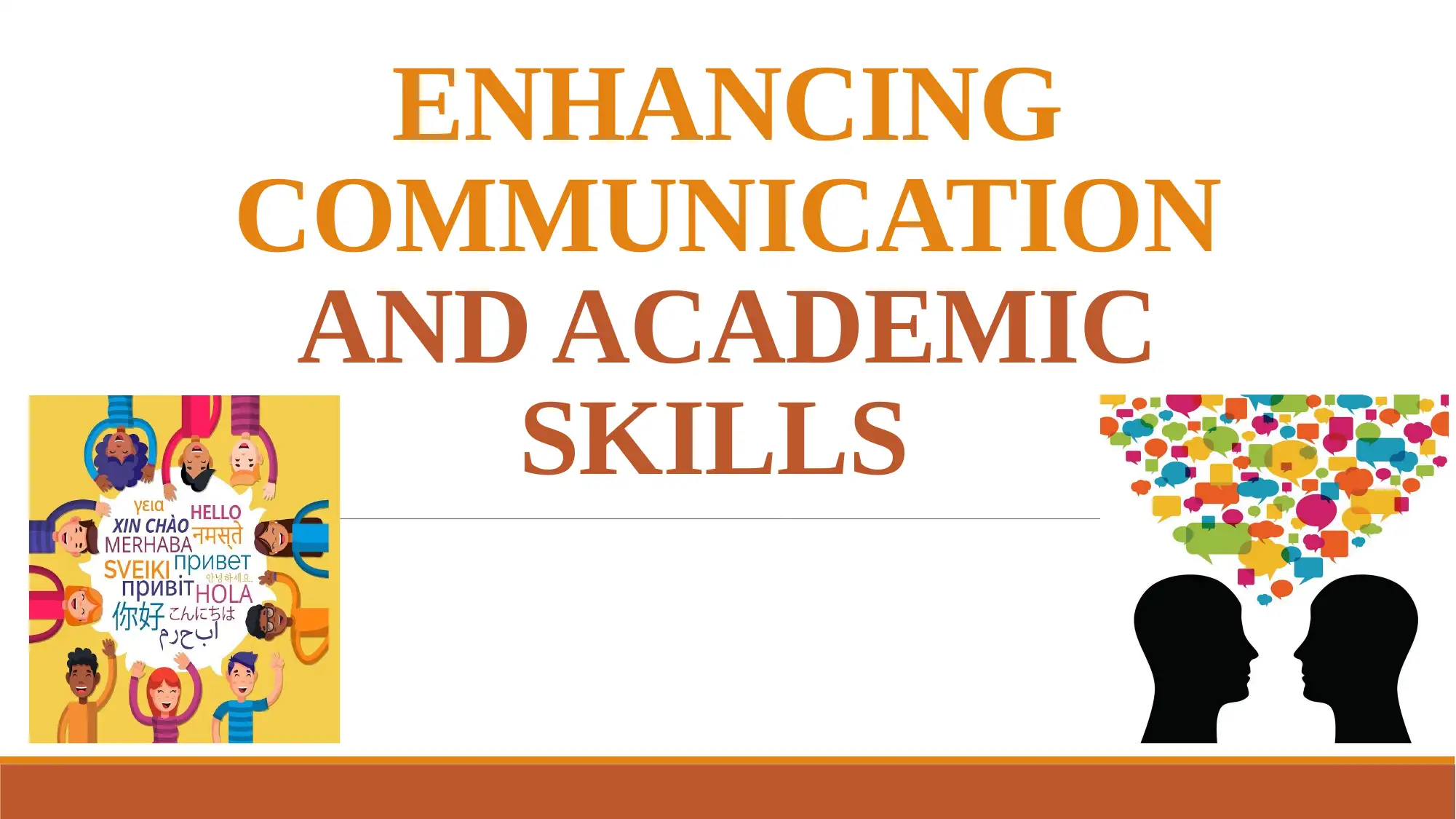
ENHANCING
COMMUNICATION
AND ACADEMIC
SKILLS
COMMUNICATION
AND ACADEMIC
SKILLS
Paraphrase This Document
Need a fresh take? Get an instant paraphrase of this document with our AI Paraphraser
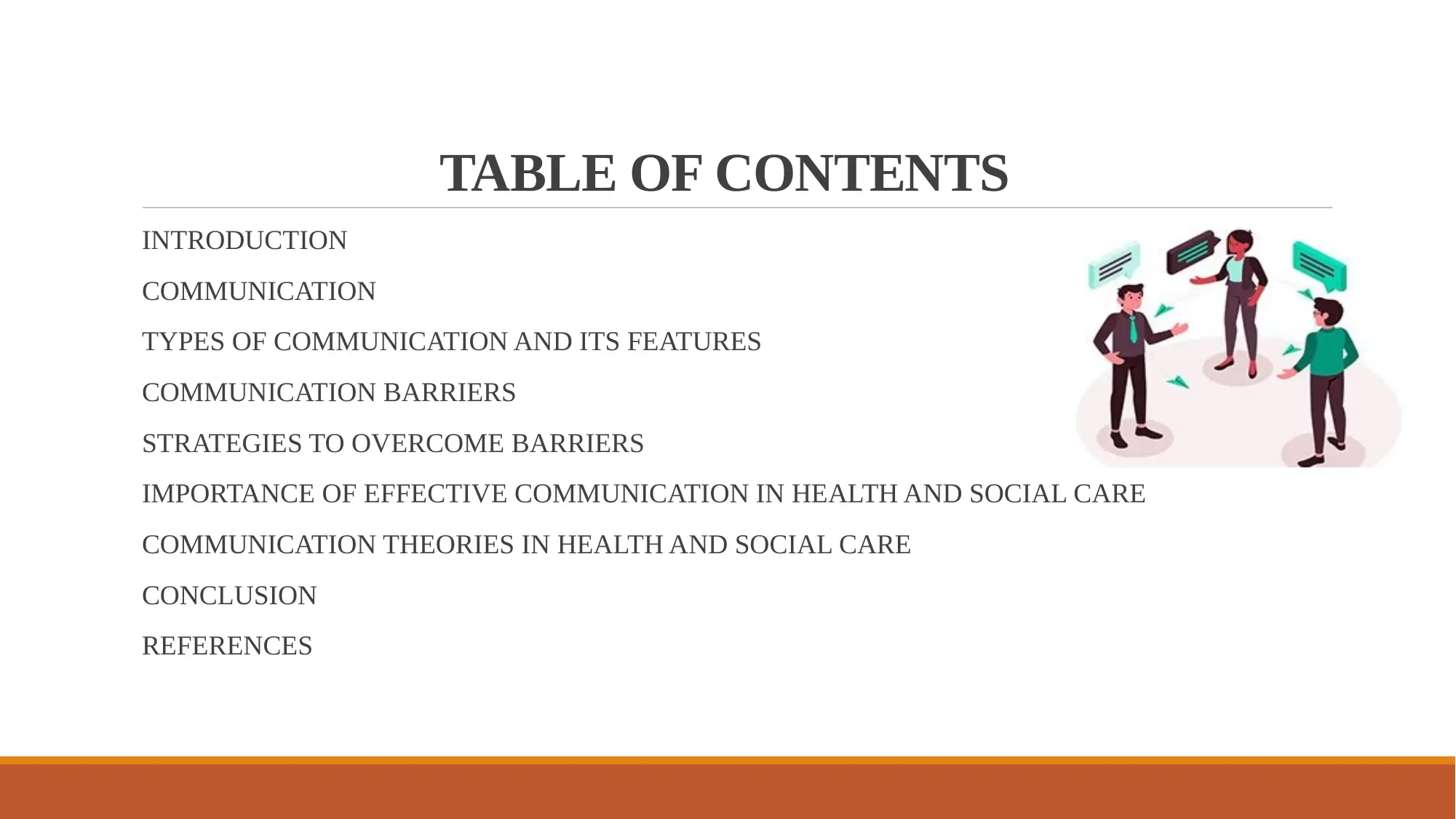
TABLE OF CONTENTS
INTRODUCTION
COMMUNICATION
TYPES OF COMMUNICATION AND ITS FEATURES
COMMUNICATION BARRIERS
STRATEGIES TO OVERCOME BARRIERS
IMPORTANCE OF EFFECTIVE COMMUNICATION IN HEALTH AND SOCIAL CARE
COMMUNICATION THEORIES IN HEALTH AND SOCIAL CARE
CONCLUSION
REFERENCES
INTRODUCTION
COMMUNICATION
TYPES OF COMMUNICATION AND ITS FEATURES
COMMUNICATION BARRIERS
STRATEGIES TO OVERCOME BARRIERS
IMPORTANCE OF EFFECTIVE COMMUNICATION IN HEALTH AND SOCIAL CARE
COMMUNICATION THEORIES IN HEALTH AND SOCIAL CARE
CONCLUSION
REFERENCES
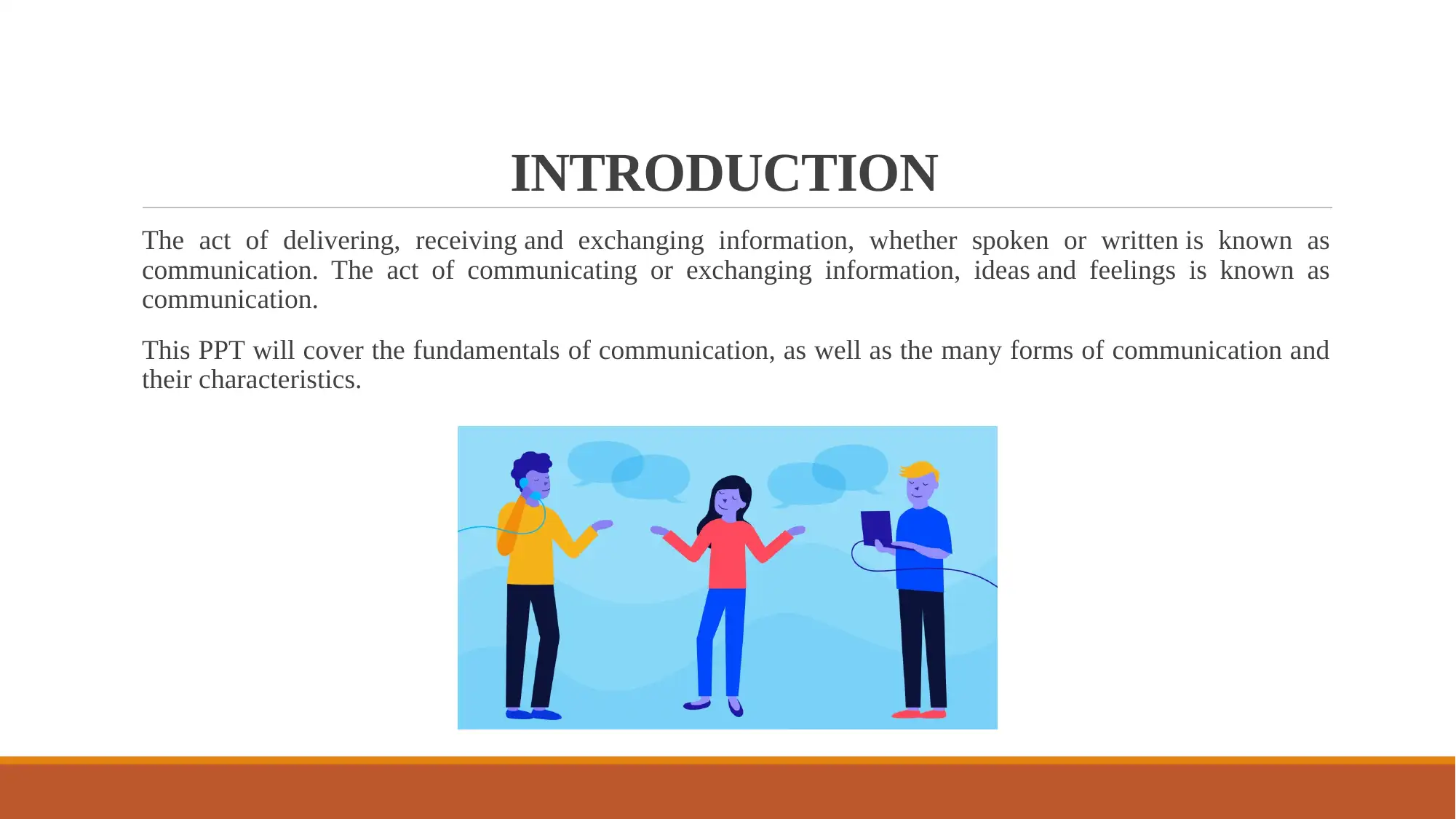
INTRODUCTION
The act of delivering, receiving and exchanging information, whether spoken or written is known as
communication. The act of communicating or exchanging information, ideas and feelings is known as
communication.
This PPT will cover the fundamentals of communication, as well as the many forms of communication and
their characteristics.
The act of delivering, receiving and exchanging information, whether spoken or written is known as
communication. The act of communicating or exchanging information, ideas and feelings is known as
communication.
This PPT will cover the fundamentals of communication, as well as the many forms of communication and
their characteristics.
⊘ This is a preview!⊘
Do you want full access?
Subscribe today to unlock all pages.

Trusted by 1+ million students worldwide
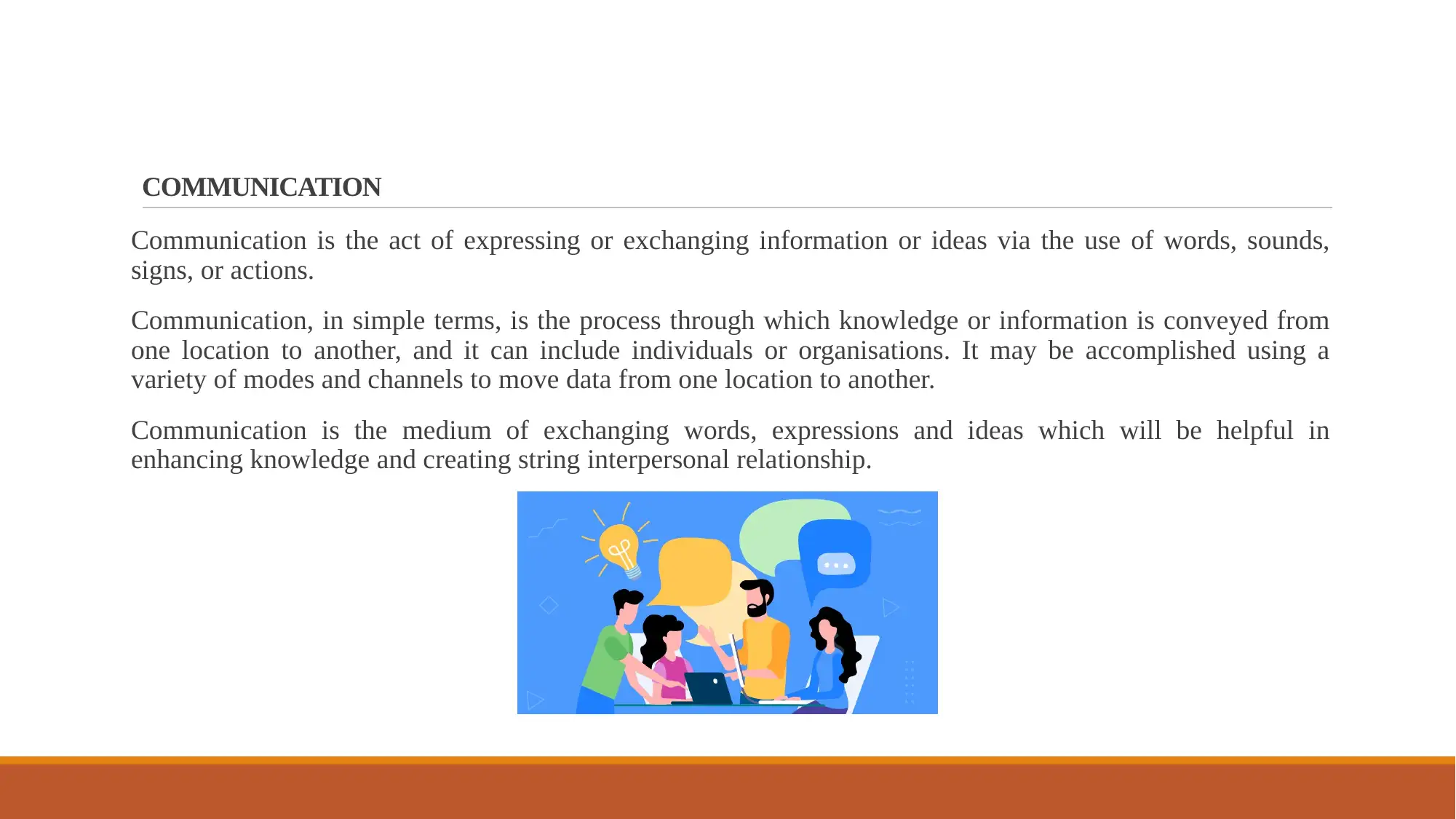
COMMUNICATION
Communication is the act of expressing or exchanging information or ideas via the use of words, sounds,
signs, or actions.
Communication, in simple terms, is the process through which knowledge or information is conveyed from
one location to another, and it can include individuals or organisations. It may be accomplished using a
variety of modes and channels to move data from one location to another.
Communication is the medium of exchanging words, expressions and ideas which will be helpful in
enhancing knowledge and creating string interpersonal relationship.
Communication is the act of expressing or exchanging information or ideas via the use of words, sounds,
signs, or actions.
Communication, in simple terms, is the process through which knowledge or information is conveyed from
one location to another, and it can include individuals or organisations. It may be accomplished using a
variety of modes and channels to move data from one location to another.
Communication is the medium of exchanging words, expressions and ideas which will be helpful in
enhancing knowledge and creating string interpersonal relationship.
Paraphrase This Document
Need a fresh take? Get an instant paraphrase of this document with our AI Paraphraser
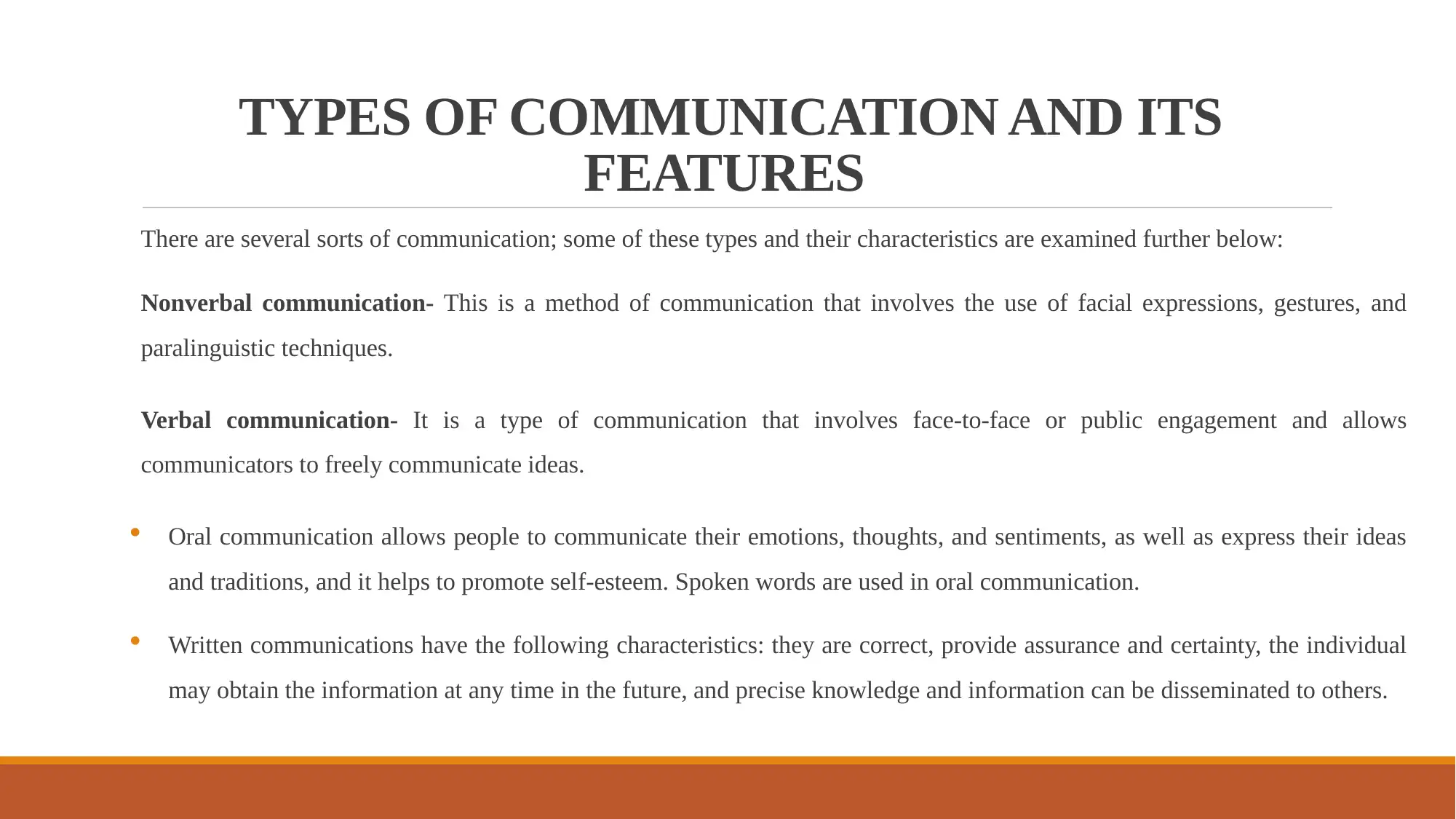
TYPES OF COMMUNICATION AND ITS
FEATURES
There are several sorts of communication; some of these types and their characteristics are examined further below:
Nonverbal communication- This is a method of communication that involves the use of facial expressions, gestures, and
paralinguistic techniques.
Verbal communication- It is a type of communication that involves face-to-face or public engagement and allows
communicators to freely communicate ideas.
Oral communication allows people to communicate their emotions, thoughts, and sentiments, as well as express their ideas
and traditions, and it helps to promote self-esteem. Spoken words are used in oral communication.
Written communications have the following characteristics: they are correct, provide assurance and certainty, the individual
may obtain the information at any time in the future, and precise knowledge and information can be disseminated to others.
FEATURES
There are several sorts of communication; some of these types and their characteristics are examined further below:
Nonverbal communication- This is a method of communication that involves the use of facial expressions, gestures, and
paralinguistic techniques.
Verbal communication- It is a type of communication that involves face-to-face or public engagement and allows
communicators to freely communicate ideas.
Oral communication allows people to communicate their emotions, thoughts, and sentiments, as well as express their ideas
and traditions, and it helps to promote self-esteem. Spoken words are used in oral communication.
Written communications have the following characteristics: they are correct, provide assurance and certainty, the individual
may obtain the information at any time in the future, and precise knowledge and information can be disseminated to others.
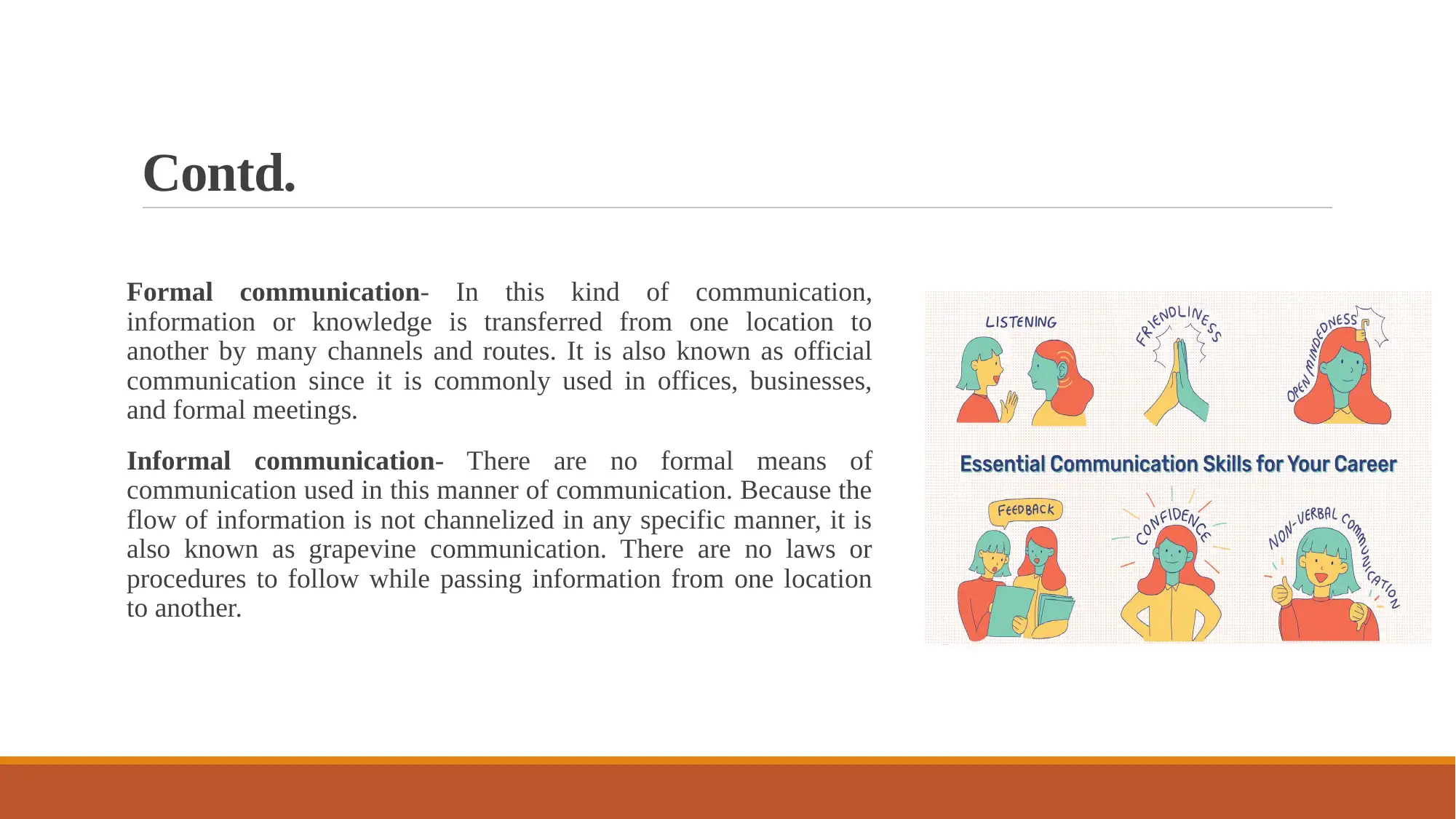
Contd.
Formal communication- In this kind of communication,
information or knowledge is transferred from one location to
another by many channels and routes. It is also known as official
communication since it is commonly used in offices, businesses,
and formal meetings.
Informal communication- There are no formal means of
communication used in this manner of communication. Because the
flow of information is not channelized in any specific manner, it is
also known as grapevine communication. There are no laws or
procedures to follow while passing information from one location
to another.
Formal communication- In this kind of communication,
information or knowledge is transferred from one location to
another by many channels and routes. It is also known as official
communication since it is commonly used in offices, businesses,
and formal meetings.
Informal communication- There are no formal means of
communication used in this manner of communication. Because the
flow of information is not channelized in any specific manner, it is
also known as grapevine communication. There are no laws or
procedures to follow while passing information from one location
to another.
⊘ This is a preview!⊘
Do you want full access?
Subscribe today to unlock all pages.

Trusted by 1+ million students worldwide
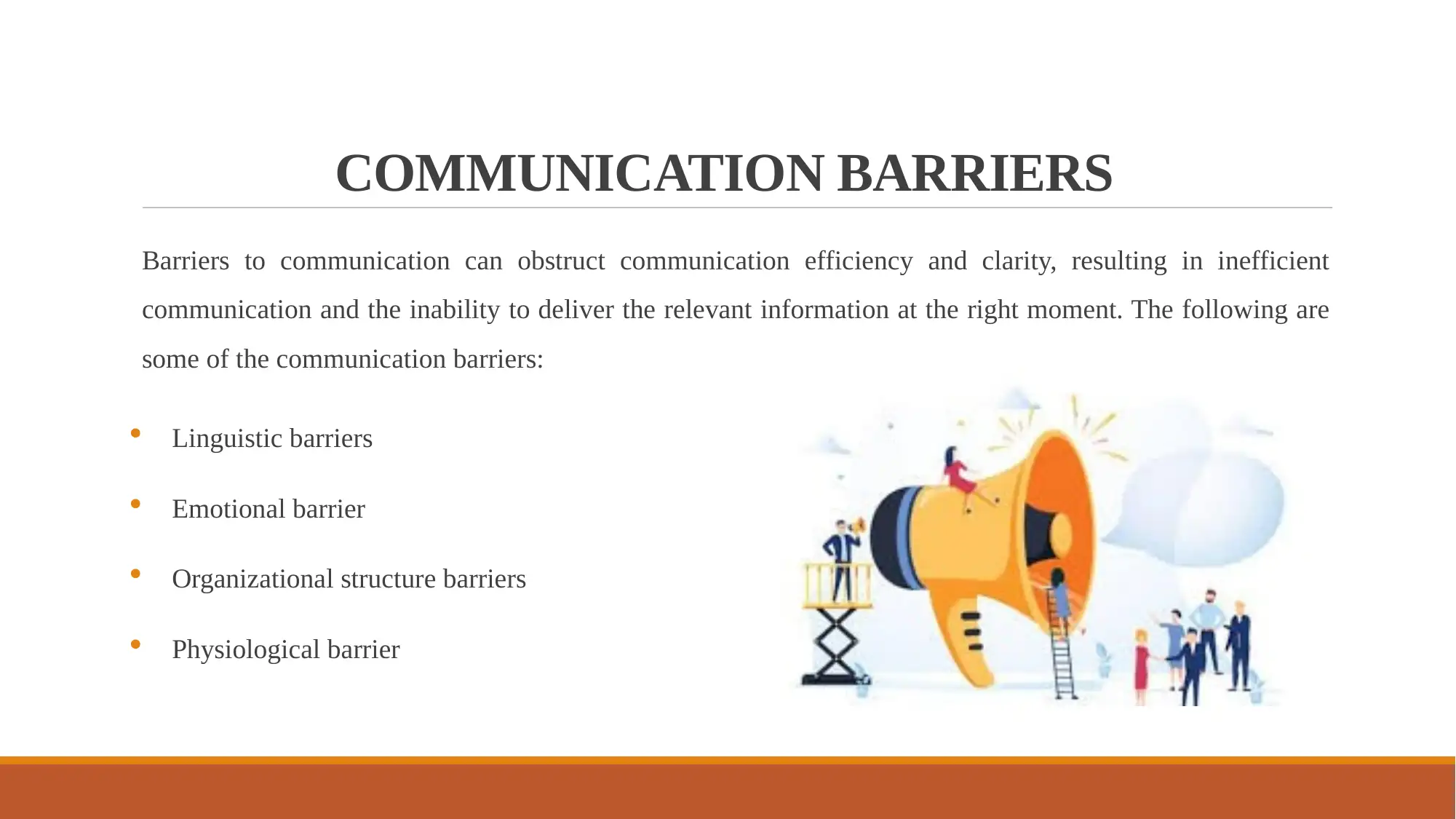
COMMUNICATION BARRIERS
Barriers to communication can obstruct communication efficiency and clarity, resulting in inefficient
communication and the inability to deliver the relevant information at the right moment. The following are
some of the communication barriers:
Linguistic barriers
Emotional barrier
Organizational structure barriers
Physiological barrier
Barriers to communication can obstruct communication efficiency and clarity, resulting in inefficient
communication and the inability to deliver the relevant information at the right moment. The following are
some of the communication barriers:
Linguistic barriers
Emotional barrier
Organizational structure barriers
Physiological barrier
Paraphrase This Document
Need a fresh take? Get an instant paraphrase of this document with our AI Paraphraser
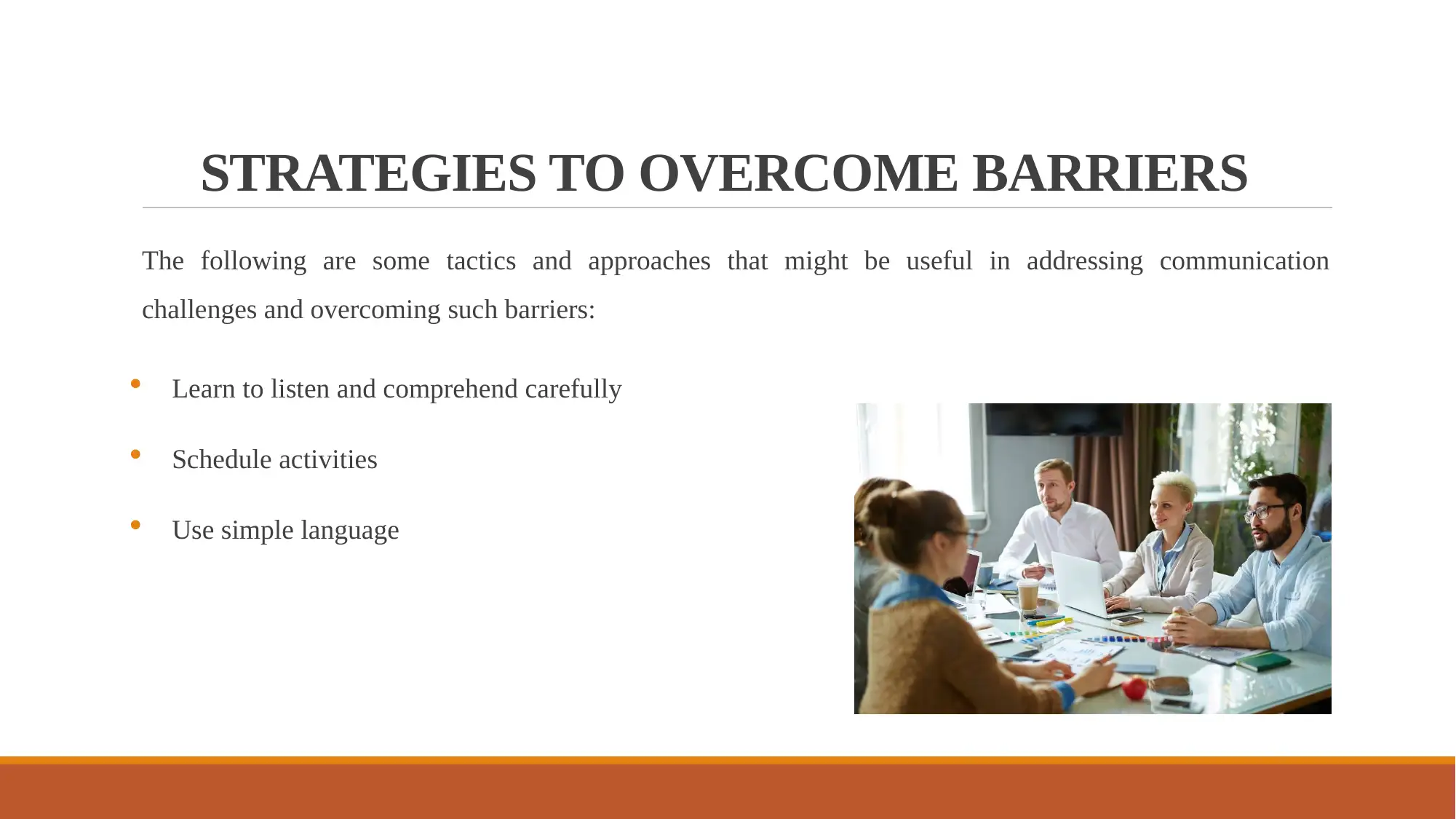
STRATEGIES TO OVERCOME BARRIERS
The following are some tactics and approaches that might be useful in addressing communication
challenges and overcoming such barriers:
Learn to listen and comprehend carefully
Schedule activities
Use simple language
The following are some tactics and approaches that might be useful in addressing communication
challenges and overcoming such barriers:
Learn to listen and comprehend carefully
Schedule activities
Use simple language
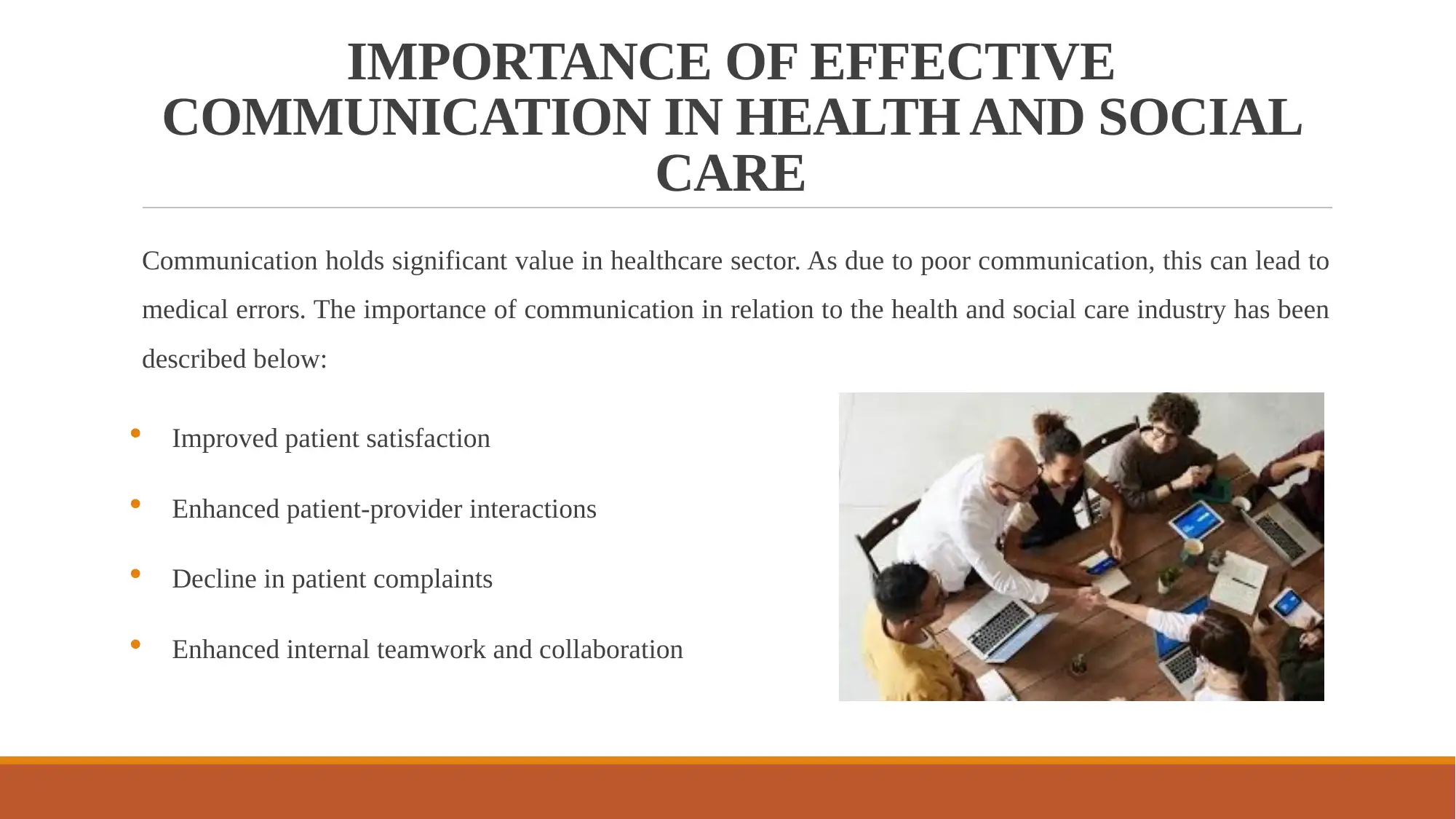
IMPORTANCE OF EFFECTIVE
COMMUNICATION IN HEALTH AND SOCIAL
CARE
Communication holds significant value in healthcare sector. As due to poor communication, this can lead to
medical errors. The importance of communication in relation to the health and social care industry has been
described below:
Improved patient satisfaction
Enhanced patient-provider interactions
Decline in patient complaints
Enhanced internal teamwork and collaboration
COMMUNICATION IN HEALTH AND SOCIAL
CARE
Communication holds significant value in healthcare sector. As due to poor communication, this can lead to
medical errors. The importance of communication in relation to the health and social care industry has been
described below:
Improved patient satisfaction
Enhanced patient-provider interactions
Decline in patient complaints
Enhanced internal teamwork and collaboration
⊘ This is a preview!⊘
Do you want full access?
Subscribe today to unlock all pages.

Trusted by 1+ million students worldwide
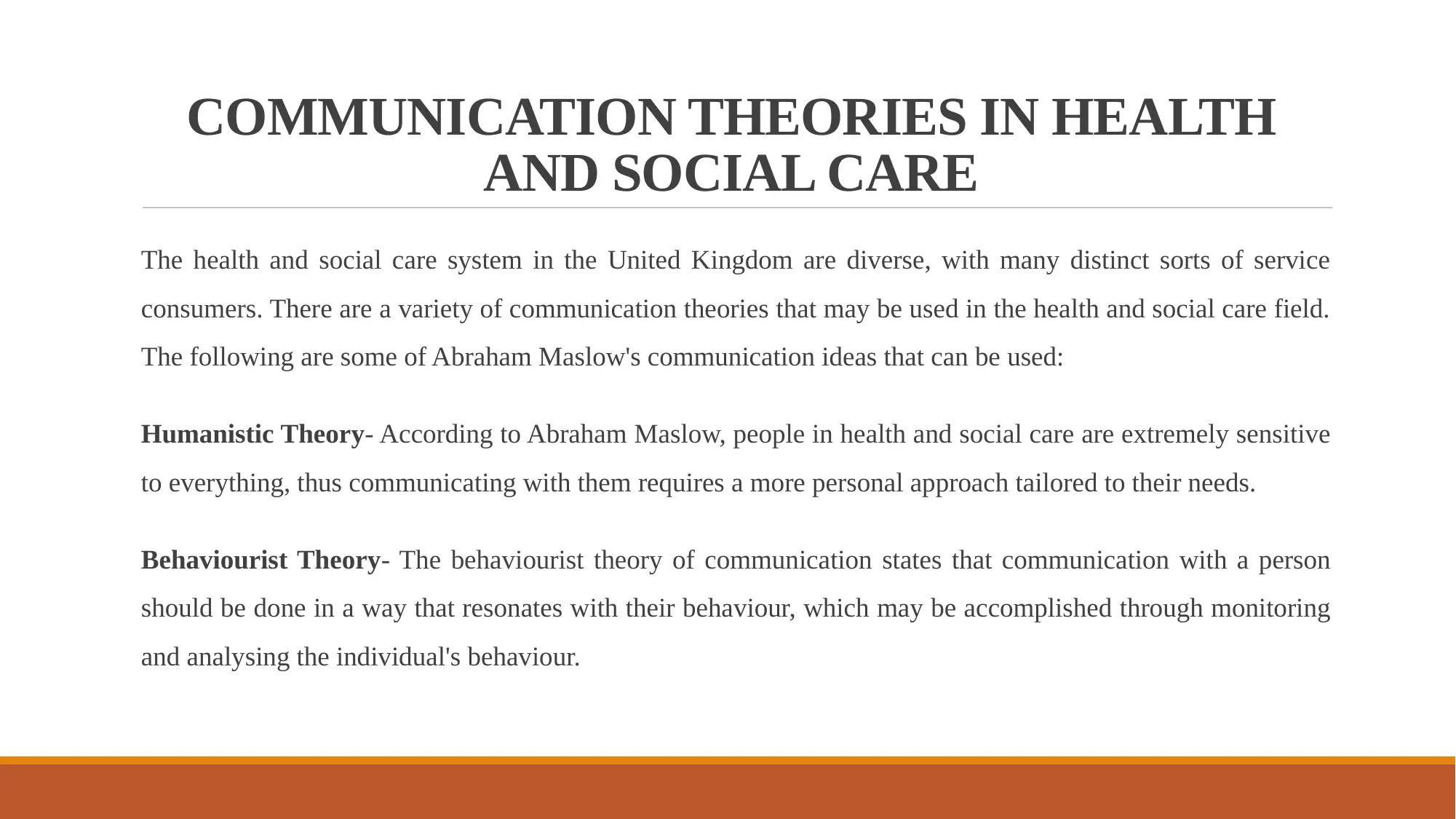
COMMUNICATION THEORIES IN HEALTH
AND SOCIAL CARE
The health and social care system in the United Kingdom are diverse, with many distinct sorts of service
consumers. There are a variety of communication theories that may be used in the health and social care field.
The following are some of Abraham Maslow's communication ideas that can be used:
Humanistic Theory- According to Abraham Maslow, people in health and social care are extremely sensitive
to everything, thus communicating with them requires a more personal approach tailored to their needs.
Behaviourist Theory- The behaviourist theory of communication states that communication with a person
should be done in a way that resonates with their behaviour, which may be accomplished through monitoring
and analysing the individual's behaviour.
AND SOCIAL CARE
The health and social care system in the United Kingdom are diverse, with many distinct sorts of service
consumers. There are a variety of communication theories that may be used in the health and social care field.
The following are some of Abraham Maslow's communication ideas that can be used:
Humanistic Theory- According to Abraham Maslow, people in health and social care are extremely sensitive
to everything, thus communicating with them requires a more personal approach tailored to their needs.
Behaviourist Theory- The behaviourist theory of communication states that communication with a person
should be done in a way that resonates with their behaviour, which may be accomplished through monitoring
and analysing the individual's behaviour.
Paraphrase This Document
Need a fresh take? Get an instant paraphrase of this document with our AI Paraphraser
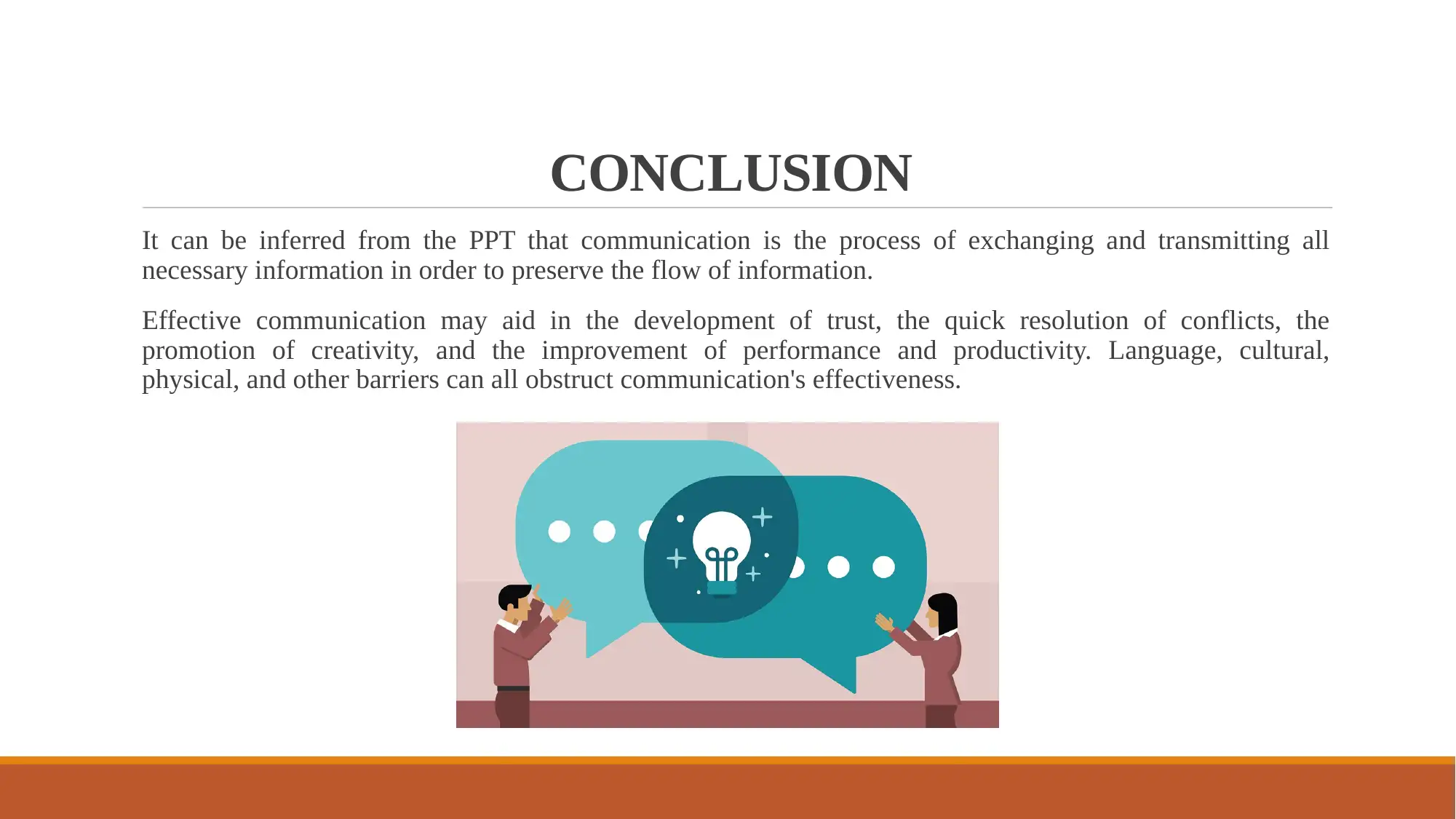
CONCLUSION
It can be inferred from the PPT that communication is the process of exchanging and transmitting all
necessary information in order to preserve the flow of information.
Effective communication may aid in the development of trust, the quick resolution of conflicts, the
promotion of creativity, and the improvement of performance and productivity. Language, cultural,
physical, and other barriers can all obstruct communication's effectiveness.
It can be inferred from the PPT that communication is the process of exchanging and transmitting all
necessary information in order to preserve the flow of information.
Effective communication may aid in the development of trust, the quick resolution of conflicts, the
promotion of creativity, and the improvement of performance and productivity. Language, cultural,
physical, and other barriers can all obstruct communication's effectiveness.
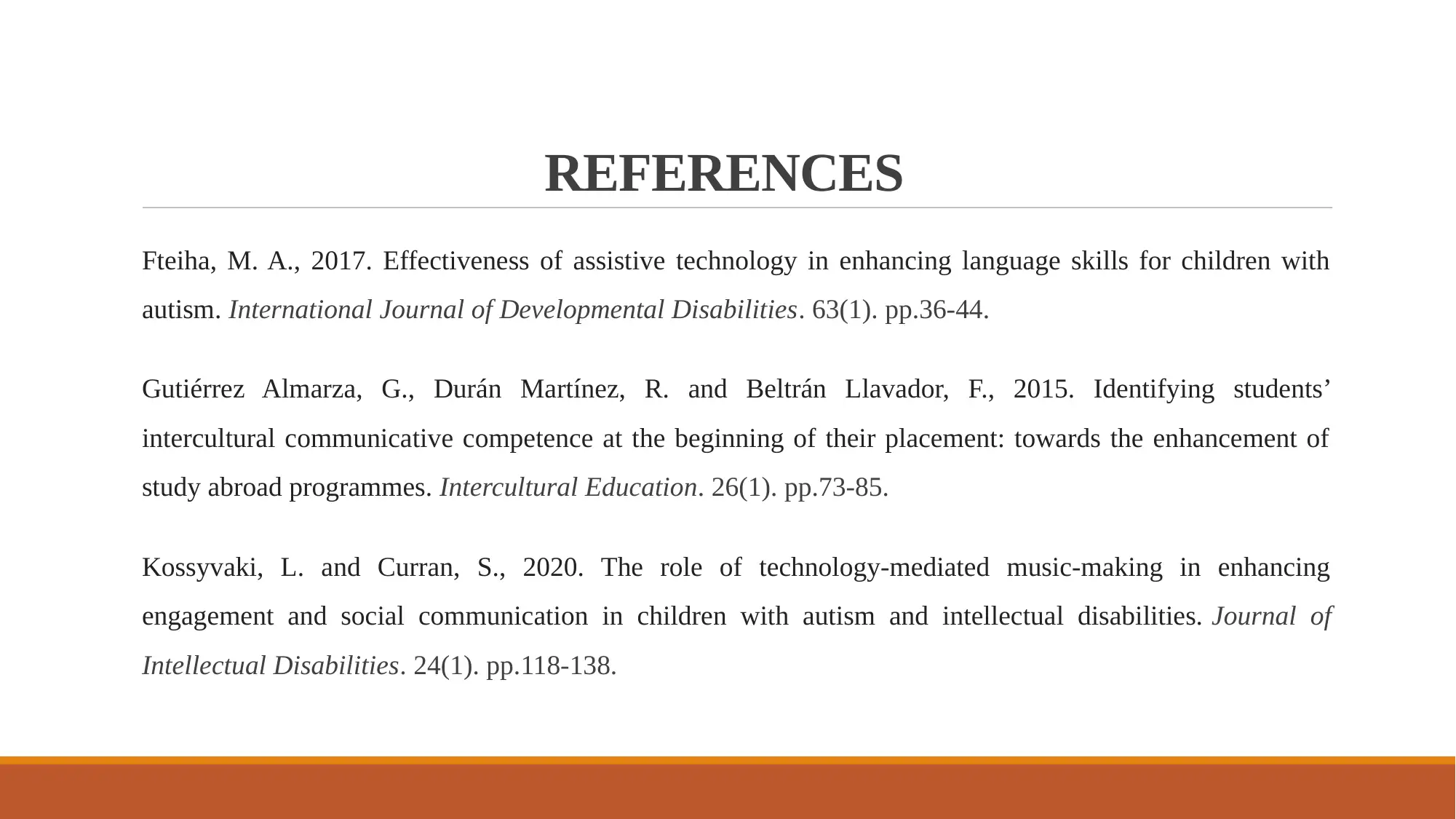
REFERENCES
Fteiha, M. A., 2017. Effectiveness of assistive technology in enhancing language skills for children with
autism. International Journal of Developmental Disabilities. 63(1). pp.36-44.
Gutiérrez Almarza, G., Durán Martínez, R. and Beltrán Llavador, F., 2015. Identifying students’
intercultural communicative competence at the beginning of their placement: towards the enhancement of
study abroad programmes. Intercultural Education. 26(1). pp.73-85.
Kossyvaki, L. and Curran, S., 2020. The role of technology-mediated music-making in enhancing
engagement and social communication in children with autism and intellectual disabilities. Journal of
Intellectual Disabilities. 24(1). pp.118-138.
Fteiha, M. A., 2017. Effectiveness of assistive technology in enhancing language skills for children with
autism. International Journal of Developmental Disabilities. 63(1). pp.36-44.
Gutiérrez Almarza, G., Durán Martínez, R. and Beltrán Llavador, F., 2015. Identifying students’
intercultural communicative competence at the beginning of their placement: towards the enhancement of
study abroad programmes. Intercultural Education. 26(1). pp.73-85.
Kossyvaki, L. and Curran, S., 2020. The role of technology-mediated music-making in enhancing
engagement and social communication in children with autism and intellectual disabilities. Journal of
Intellectual Disabilities. 24(1). pp.118-138.
⊘ This is a preview!⊘
Do you want full access?
Subscribe today to unlock all pages.

Trusted by 1+ million students worldwide
1 out of 12
Related Documents
Your All-in-One AI-Powered Toolkit for Academic Success.
+13062052269
info@desklib.com
Available 24*7 on WhatsApp / Email
![[object Object]](/_next/static/media/star-bottom.7253800d.svg)
Unlock your academic potential
Copyright © 2020–2025 A2Z Services. All Rights Reserved. Developed and managed by ZUCOL.



